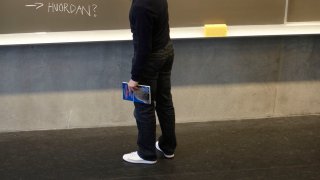Students in higher education
Updated: 5 April 2024
Next update: Not yet determined
| 2013 | 2022 | 2023 | |
|---|---|---|---|
| Students | |||
| Total | 269 063 | 310 934 | 311 765 |
| Males | 109 700 | 123 830 | 122 827 |
| Females | 159 363 | 187 104 | 188 938 |
| Student proportion among 19-24 year olds | |||
| Total | 33.7 | 37.4 | 36.7 |
| Males | 27.5 | 29.4 | 28.8 |
| Females | 40.1 | 45.9 | 45.1 |
| Student proportion among 25-29 year olds | |||
| Total | 15.0 | 16.6 | 17.0 |
| Males | 13.3 | 14.2 | 14.6 |
| Females | 16.8 | 19.0 | 19.6 |
More figures from this statistics
- 03814: Students in higher education in Norway. Sex and college municipality (M)
- 09504: Students in selected education programmes in higher education in Norway. Length of study, immigration category and sex
- 08823: Students in higher education in Norway and abroad. Sex and field of education
- 08103: Resident students in higher education in Norway and abroad, in per cent of registered cohort. Immigration category, selected age groups and region
- 04476: Students from Norway in higher education abroad. Sex and countries of study
About the statistics
The statistics include all students registered in higher education as of October 1. Persons enrolled in doctoral programs (PhD) are not included. Students taking an entire study program abroad are included, whereas exchange students are excluded. Statistics on new students in higher education are updated in June.
Enrolled students
Students registered at an approved institution for higher education in Norway and students from Norway registered abroad in higher education, excluding exchange students.
Type of school
According to the Standard Industrial Classification of 2007. The schools are classified as Universities, Specialized University Institutions, and University Colleges, where University Colleges are again divided into three main groups: State University Colleges, Military Colleges and “other university colleges”.
Educational activity
According to the Norwegian Standard Classification of Education (NUS2000). Programmes are classified according to their level and field of study.
School county/school municipality
The county/municipality where the institution is located.
County of residence at 16 years County where the student resided at the age 16.
Highest educational attainment of parents
Parental educational attainment is divided into four categories:
- Primary and lower secondary education
- Upper secondary education
- Higher education, short (at least two years, but also 4 years or less)
- Higher education, long (more than four years)
Parental educational attainment is defined by the one parent with the highest level of education. For example, if the parental educational attainment of a student is “Higher education, short,” it implies that at least one of the parents has education at this level. Cases where there is no information on the level of education of any of the parents falls into the “Unspecified” group. See also the definitions of educational level.
Immigrants
Persons born abroad of two foreign-born parents and four foreign-born grandparents.
Norwegian-born to immigrant parents
Persons who are born in Norway of two parents born abroad, and in addition have four grandparents born abroad.
Teacher training and pedagogy programmes include
Teacher training programme; Various bachelor’s programmes in pre-school/kindergarten teacher education, specific subject/vocational teacher education and within pedagogy; General teacher/primary and lower secondary teacher programme and specific subject/vocational teacher education; Master’s programmes in teacher training and pedagogy; Postgraduate programmes for teachers.
Age Estimated as of December 31.
Educational activities are grouped by the Norwegian Standard Classification of Education which was established in 1970 by Statistics Norway and later revised in 1973, 1989 and 2000. Educational institutions are classified as being higher education by the Standard Industrial Classification.
For international purposes, the ISCED 2011 is used (International Standard Classification of Education).
Name: Students in higher education
Topic: Education
Division for Education and Culture Statistics
Figures are presented at national level, at municipal level and by educational institution. Data on enrolment in higher education include information that makes it possible to provide figures at other regional levels.
Figures are published annually in April. As of 2015 data on credit points was merged with data on graduations from universities and colleges. Prior to 2015 data on credit points was published separately.
The data is provided for UNESCO, OECD and Eurostat (U-O-E).
Collected and revised data are stored securely by Statistics Norway in compliance with applicable legislation on data processing.
Statistics Norway can grant access to the source data (de-identified or anonymised microdata) on which the statistics are based, for researchers and public authorities for the purposes of preparing statistical results and analyses. Access can be granted upon application and subject to conditions. Refer to the details about this at Access to data from Statistics Norway.
There is a high demand for the collection of official statistics on education. Official education statistics are individually based and document the educational activities of all Norwegian residents from completion of lower secondary school to completion of all higher education including doctoral/PhD studies.
Norway’s education statistics went through a structural readjustment in the beginning of the 1970’s. All statistics on higher education were previously available through a census. The data is now individually based, where all educational activities are attached to each individual’s personal ID-number. The data is contained in the National Education Database (NUDB), in a format that allows the production of different kinds of education statistics and alignment with other types of individually based statistics where necessary (e.g. income, social-welfare).
The purpose of the statistics is to present individually based statistics of graduates and attained credit points in higher education in Norway.
Important users of the education statistics are the Ministry of Education and Research, public administration, researchers, special interest organisations, international organisations (Eurostat, OECD and UNESCO), media, business and industry. In addition, data is used internally in Statistics Norway in publications and in assignments.
No external users have access to statistics before they are released at 8 a.m. on ssb.no after at least three months’ advance notice in the release calendar. This is one of the most important principles in Statistics Norway for ensuring the equal treatment of users.
Data from higher education is combined with data from lower- and upper secondary education when revision processes are complete. Data is then stored as single annual files in the National Education Database (NUDB). Statistics Norway uses a similar system for all individually based statistics, making it easy to combine education statistics with other statistics. Labour market statistics, health statistics, living conditions statistics and income and wage statistics are examples of other individually based statistics compiled by Statistics Norway.
The statistics are developed, produced and disseminated pursuant to Act no. 32 of 21 June 2019 relating to official statistics and Statistics Norway (the Statistics Act).
Commission Regulation (EU) No 88/2011 of 2 February 2011 implementing Regulation (EC) No 452/2008 of the European Parliament and of the Council concerning the production and development of statistics on education and lifelong learning, as regards statistics on education and training systems.
The statistics cover all students of educational institutions that are classified as universities, specialised universities or university colleges in the Standard Industrial Classification per 1 October each year.
University Colleges are grouped into: State University Colleges, Military University Colleges and “other university colleges.” State University College is a term derived from the reform of 1994 in colleges in Norway, which resulted in the consolidation of 98 smaller state colleges into 26 larger units.
In recent years, a number of institutions in higher education has been merged into larger units, see changes in educational institutions (in Norwegian).
As some University Colleges were merged in 2016 into larger units, there was a decrease in the number of students in University Colleges, as well as a corresponding increase in the number of students in Universities and in Specialized University Institutions.
There are several criteria for how a student’s educational activity is recorded. Each student can be registered as active in only one educational activity, although he/she may be registered for several educational activities or educational institutions at the same time. If a student is registered for several activities or several institutions at the same time, education at the highest level is maintained above others, educational activity at a Specialised University Institution is chosen over education at other types of school, and full-time activity is chosen over part-time activities. If a student is enrolled in several part-time educational activities, the one with highest level is chosen. Persons in doctoral programmes (PhD) are not included.
Information on students abroad only includes students who take a whole degree abroad, excluding exchange students.
Pursuant to the Statistical Act, Statistics Norway collects student data from Database for Statistics on Higher Education (DBH) and the administrative systems of various higher education institutions.
Information on students abroad is provided by the State Education Loan Fund.
Surveys are not employed to collect education statistics. All data is obtained from university and college databases.
Data collection
Pursuant to the Statistical Act (June 1989, No.54), Statistics Norway collects student data from Database for Statistics on Higher Education (DBH), the administrative systems of various higher education institutions, and the State Education Loan Fund.
Editing
Editing is defined here as checking, examining and amending data. Editing includes both control and revision and is performed on all educational data collected. It encompasses deletion of duplicate records, a control for correct and valid values for each variable, comparisons with last year’s data and checks for missing information. Several variables are re-coded to comply with control programs run by Statistics Norway. Personal ID-numbers are referenced against Statistics Norway’s population database to check for errors. At last, duplicate students are deleted, which implies that a student can only be counted once although the student may be registered for several educational activities or educational institutions at the same time.
Estimation
No estimation is performed. The statistics are based data obtained from university and college databases.
Not relevant.
Interviewers and everyone who works at Statistics Norway have a duty of confidentiality. Statistics Norway has its own data protection officer.
Statistics Norway does not publish figures where there is a risk of identifying individual data about persons.
The suppression method is used in these statistics to ensure this.
More information can be found on Statistics Norway’s website under Methods in official statistics, in the ‘Confidentiality’ section.
Individually based data on completed education has been published annually since it was first collected in the academic year 1973/74. Most variables are comparable, but some have changed. The Norwegian Standard Classification of Education (NUS2000) has been revised to secure comparability over time. While educational variables are reasonably comparable over time, other variables, e.g. various institution types, cannot be re-coded and thus not comparable over time.
Statistical investigations may encounter various sources of error. The errors may occur either during data collection (in this case, registration of student information) or during data processing (control and revision processes performed by Statistics Norway).
It is difficult to estimate the extent of error in student registers. A person may be wrongly registered as being a student, especially for individual institutions that use a different enumeration date than Statistics Norway (October 1). There could be an overestimation of enrolled students since student registration occur with payment of registration fees rather than enrolment in courses. In addition, some students could remain as enrolled students in the system even after graduating. There is also the possibility of students reporting inaccurate information about themselves in registration. Personal responsible for reporting student data at institutions could also make errors during data processing.
Information on students abroad is provided by the State Education Loan Fund. However, Norwegian students abroad who are not registered in the State Education Loan Fund’s system are missed out in the statistics.
A revision is a planned change to figures that have already been published, for example when releasing final figures as a follow-up to published preliminary figures. See also Statistics Norway’s principles for revisions.


